Describing a Multiply Occurring Field in a Fixed-Format, VSAM, or ISAM Data Source
Fixed-format sequential, VSAM,
or ISAM data sources can have repeating fields. Consider the following
data structure:
Fields C1 and C2 repeat within this data record. C1 has an initial
value, as does C2. C1 then provides a second value for that field,
as does C2. Thus, there are two values for fields C1 and C2 for
every one value for fields A and B.
The number of times C1 and C2 occur does not have to be fixed.
It can depend on the value of a counter field. Suppose field B is
this counter field. In the case shown above, the value of field
B is 2, since C1 and C2 occur twice. The value of field B in the
next record can be 7, 1, 0, or any other number you choose, and
fields C1 and C2 occur that number of times.
The number of times fields C1 and C2 occur can also be variable.
In this case, everything after fields A and B is assumed to be a
series of C1s and C2s, alternating to the end of the record.
Describe these multiply occurring fields by placing them in a
separate segment. Fields A and B are placed in the root segment.
Fields C1 and C2, which occur multiply in relation to A and B, are
placed in a descendant segment. You use an additional segment attribute, the
OCCURS attribute, to specify that these segments represent multiply
occurring fields. In certain cases, you may also need a second attribute,
called the POSITION attribute.
xUsing the OCCURS Attribute
The OCCURS attribute is an optional segment attribute used to
describe records containing repeating fields or groups of fields.
Define such records by describing the singly occurring fields in
one segment, and the multiply occurring fields in a descendant segment. The
OCCURS attribute appears in the declaration for the descendant segment.
You can have several sets of repeating fields in your data structure.
Describe each of these sets of fields as a separate segment in your
data source description. Sets of repeating fields can be divided
into two basic types: parallel and nested.
x
Syntax: How to Specify a Repeating Field
OCCURS = occurstype
Possible values for occurstype are:
- n
Is an integer value showing the number of occurrences (from
1 to 4095).
- fieldname
Names a field in the parent segment or a virtual field in
an ancestor segment whose integer value contains the number of occurrences
of the descendant segment. Note that if you use a virtual field
as the OCCURS value, it cannot be redefined inside or outside of
the Master File.
- VARIABLE
Indicates that the number of occurrences varies from record
to record. The number of occurrences is computed from the record
length (for example, if the field lengths for the segment add up
to 40, and 120 characters are read in, it means there are three
occurrences).
Place
the OCCURS attribute in your segment declaration after the PARENT attribute.
When
different types of records are combined in one data source, each
record type can contain only one segment defined as OCCURS=VARIABLE.
It may have OCCURS descendants (if it contains a nested group),
but it may not be followed by any other segment with the same parent.
There can be no other segments to its right in the hierarchical
data structure. This restriction is necessary to ensure that data
in the record is interpreted unambiguously.
Example: Using the OCCURS Attribute
Consider the following simple data structure:
You have two occurrences
of fields C1 and C2 for every one occurrence of fields A and B.
Thus, to describe this data source, you place fields A and B in
the root segment, and fields C1 and C2 in a descendant segment,
as shown here:
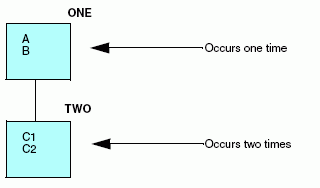
Describe this data source as follows:
FILENAME = EXAMPLE1, SUFFIX = FIX, $
SEGNAME = ONE, SEGTYPE=S0, $
FIELDNAME = A, ALIAS=, USAGE = A2, ACTUAL = A2, $
FIELDNAME = B, ALIAS=, USAGE = A1, ACTUAL = A1, $
SEGNAME = TWO, PARENT = ONE, OCCURS = 2, SEGTYPE=S0, $
FIELDNAME = C1, ALIAS=, USAGE = I4, ACTUAL = I2, $
FIELDNAME = C2, ALIAS=, USAGE = I4, ACTUAL = I2, $
xDescribing a Parallel Set of Repeating Fields
Parallel sets of repeating fields
are those that have nothing to do with one another (that is, they
have no parent-child or logical relationship). Consider the following data
structure:
A1 |
A2 |
B1 |
B2 |
B1 |
B2 |
C1 |
C2 |
C1 |
C2 |
C1 |
C2 |
In this example, fields B1 and B2 and
fields C1 and C2 repeat within the record. The number of times that
fields B1 and B2 occur has nothing to do with the number of times fields
C1 and C2 occur. Fields B1 and B2 and fields C1 and C2 are parallel
sets of repeating fields. They should be described in the data source
description as children of the same parent, the segment that contains
fields A1 and A2.
The following data structure reflects
their relationship:
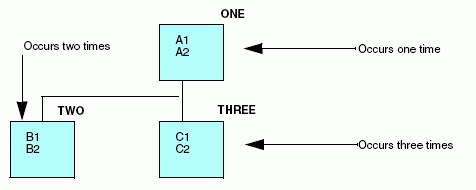
xDescribing a Nested Set of Repeating Fields
Nested sets of repeating fields
are those whose occurrence depends on one another in some way. Consider
the following data structure:
A1 |
A2 |
B1 |
B2 |
C1 |
C1 |
B1 |
B2 |
C1 |
C1 |
C1 |
In this example, field C1 only occurs
after fields B1 and B2 occur once. It occurs varying numbers of
times, recorded by a counter field, B2. There is not a set of occurrences
of C1 which is not preceded by an occurrence of fields B1 and B2.
Fields B1, B2, and C1 are a nested set of repeating fields.
These repeating fields can be represented
by the following data structure:
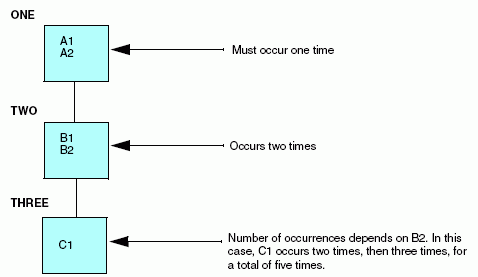
Since field C1 repeats with relation to fields B1 and B2, which
repeat in relation to fields A1 and A2, field C1 is described as
a separate, descendant segment of Segment TWO, which is in turn
a descendant of Segment ONE.
Example: Describing Parallel and Nested Repeating Fields
The following data structure contains
both nested and parallel sets of repeating fields.
A
1 |
A
2 |
B
1 |
B
2 |
C
1 |
C
1 |
C
1 |
B
1 |
B
2 |
C
1 |
C
1 |
C
1 |
C
1 |
D
1 |
D
1 |
E
1 |
E
1 |
E
1 |
E
1 |
It produces the following
data structure:
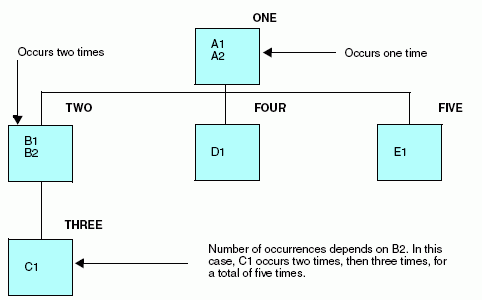
Describe this data source as follows.
Notice that the assignment of the PARENT attributes shows you how
the occurrences are nested.
FILENAME = EXAMPLE3, SUFFIX = FIX,$
SEGNAME = ONE, SEGTYPE=S0,$
FIELDNAME = A1 ,ALIAS= ,ACTUAL = A1 ,USAGE = A1 ,$
FIELDNAME = A2 ,ALIAS= ,ACTUAL = I1 ,USAGE = I1 ,$
SEGNAME = TWO, SEGTYPE=S0, PARENT = ONE, OCCURS = 2 ,$
FIELDNAME = B1 ,ALIAS= ,ACTUAL = A15 ,USAGE = A15 ,$
FIELDNAME = B2 ,ALIAS= ,ACTUAL = I1 ,USAGE = I1 ,$
SEGNAME = THREE, SEGTYPE=S0, PARENT = TWO, OCCURS = B2 ,$
FIELDNAME = C1 ,ALIAS= ,ACTUAL = A25 ,USAGE = A25 ,$
SEGNAME = FOUR, SEGTYPE=S0, PARENT = ONE, OCCURS = A2 ,$
FIELDNAME = D1 ,ALIAS= ,ACTUAL = A15 ,USAGE = A15 ,$
SEGNAME = FIVE, SEGTYPE=S0, PARENT = ONE, OCCURS = VARIABLE,$
FIELDNAME = E1 ,ALIAS= ,ACTUAL = A5 ,USAGE = A5 ,$
Note:
- Segments ONE, TWO, and THREE represent
a nested group of repeating segments. Fields B1 and B2 occur a fixed
number of times, so OCCURS equals 2. Field C1 occurs a certain number
of times within each occurrence of fields B1 and B2. The number
of times C1 occurs is determined by the value of field B2, which
is a counter. In this case, its value is 3 for the first occurrence
of Segment TWO and 4 for the second occurrence.
- Segments FOUR
and FIVE consist of fields that repeat independently within the parent
segment. They have no relationship to each other or to Segment TWO
except their common parent, so they represent a parallel group of
repeating segments.
- As in the case
of Segment THREE, the number of times Segment FOUR occurs is determined
by a counter in its parent, A2. In this case, the value of A2 is
two.
- The number of
times Segment FIVE occurs is variable. This means that all the rest of
the fields in the record (all those to the right of the first occurrence
of E1) are read as recurrences of field E1. To ensure that data
in the record is interpreted unambiguously, a segment defined as
OCCURS=VARIABLE must be at the end of the record. In a data structure
diagram, it is the rightmost segment. Note that there can be only
one segment defined as OCCURS=VARIABLE for each record type.
xUsing the POSITION Attribute
The POSITION attribute is an optional attribute used
to describe a structure in which multiply occurring fields with
an established number of occurrences are located in the middle of
the record. You describe the data source as a hierarchical structure,
made up of a parent segment and at least one child segment that
contains the multiply occurring fields. The parent segment is made
up of whatever singly occurring fields are in the record, as well
as one or more alphanumeric fields that appear where the multiply
occurring fields appear in the record. The alphanumeric field may
be a dummy field that is the exact length of the combined multiply
occurring fields. For example, if you have four occurrences of an eight-character
field, the length of the field in the parent segment is 32 characters.
You can also use the POSITION attribute to redescribe fields
with SEGTYPE=U. For more information, see Redefining a Field in a Non-FOCUS Data Source.
x
Syntax: How to Specify the Position of a Repeating Field
The POSITION attribute is described
in the child segment. It gives the name of the field in the parent
segment that specifies the starting position and overall length
of the multiply occurring fields. The syntax of the POSITION attribute
is
POSITION = fieldname
where:
- fieldname
Is the name of the field in the parent segment that defines
the starting position of the multiple field occurrences.
Example: Specifying the Position of a Repeating Field
Consider the following data structure:
In this example, field
Q1 repeats four times in the middle of the record. When you describe
this structure, you specify a field or fields that occupy the position
of the four Q1 fields in the record. You then assign the actual
Q1 fields to a multiply occurring descendant segment. The POSITION
attribute, specified in the descendant segment, gives the name of the
field in the parent segment that identifies the starting position
and overall length of the Q fields.
Use
the following Master File to describe this structure:
FILENAME = EXAMPLE3, SUFFIX = FIX,$
SEGNAME = ONE, SEGTYPE=S0,$
FIELDNAME = A1 ,ALIAS= ,USAGE = A14 ,ACTUAL = A14 ,$
FIELDNAME = QFIL ,ALIAS= ,USAGE = A32 ,ACTUAL = A32 ,$
FIELDNAME = A2 ,ALIAS= ,USAGE = I2 ,ACTUAL = I2 ,$
FIELDNAME = A3 ,ALIAS= ,USAGE = A10 ,ACTUAL = A10 ,$
FIELDNAME = A4 ,ALIAS= ,USAGE = A15 ,ACTUAL = A15 ,$
SEGNAME = TWO, SEGTYPE=S0, PARENT = ONE, POSITION = QFIL, OCCURS = 4 ,$
FIELDNAME = Q1 ,ALIAS= ,USAGE = D8 ,ACTUAL = D8 ,$
This produces the following structure:
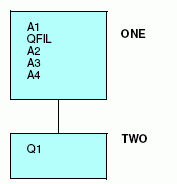
If
the total length of the multiply occurring fields is longer than
4095, you can use a filler field after the dummy field to make up
the remaining length. This is required, because the format of an
alphanumeric field cannot exceed 4095 bytes.
Notice that this
structure works only if you have a fixed number of occurrences of
the repeating field. This means the OCCURS attribute of the descendant
segment must be of the type OCCURS=n. OCCURS=fieldname or
OCCURS=VARIABLE does not work.
xSpecifying the ORDER Field
In an OCCURS segment, the order of the data may be significant.
For example, the values may represent monthly or quarterly data,
but the record itself may not explicitly specify the month or quarter
to which the data applies.
To associate a sequence number with each occurrence of the field,
you may define an internal counter field in any OCCURS segment.
A value is automatically supplied that defines the sequence number
of each repeating group.
x
Syntax: How to Specify the Sequence of a Repeating Field
The syntax
rules for an ORDER field are:
- It must be the last field described
in an OCCURS segment.
- The field name is arbitrary.
- The ALIAS is ORDER.
- The USAGE is In, with any appropriate
edit options.
- The ACTUAL is I4.
Order values
are 1, 2, 3, and so on, within each occurrence of the segment. The
value is assigned prior to any selection tests that might accept
or reject the record, and so it can be used in a selection test.
Example: Using the ORDER Attribute in a Selection Test
The following declaration assigns ACT_MONTH
as the ORDER field:
FIELD = ACT_MONTH, ALIAS = ORDER, USAGE = I2MT, ACTUAL = I4, $
The following WHERE test obtains data
for only the month of June:
SUM AMOUNT...
WHERE ACT_MONTH IS 6
The
ORDER field is a virtual field used internally. It does not alter
the logical record length (LRECL) of the data source being accessed.




